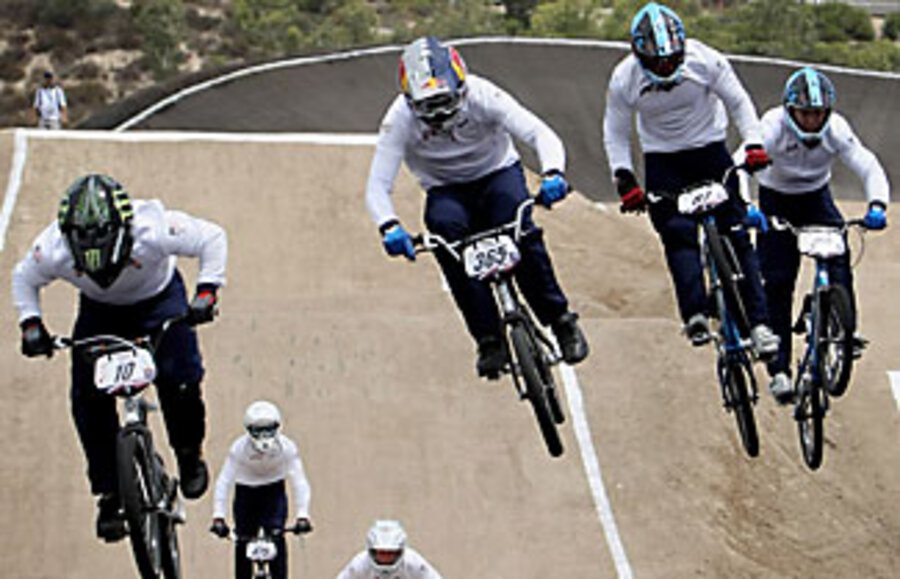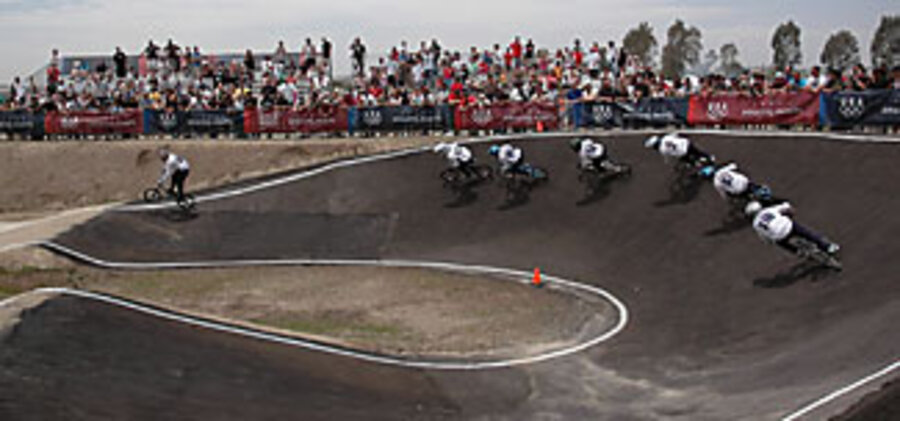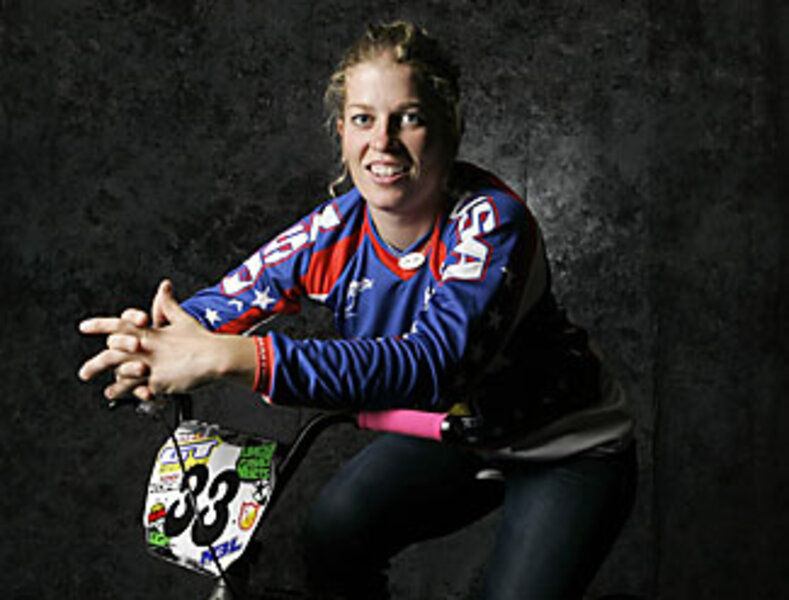For extreme sports fans, Olympics adds jumping cyclists
Loading...
| Chula Vista, Calif.; and Chicago
The Summer Olympics have been searching for Jill Kintner.
It takes a peculiar sort of person to do what she does on the BMX racing circuit – jumping 40-foot gaps and plunging down three-story start ramps, pedaling furiously at speeds that would get cars a ticket in a school zone.
She is Evel Knievel on a dirt bike, and for all the Summer Olympics' cultural and athletic gravitas, it has never had what Kintner and her fellow riders offer: street cred among America's suburban set.
The addition of BMX racing to the Beijing Games is a clear attempt by the International Olympic Committee (IOC) to bring snowboarding's extreme-sports chic to the summer side – exchanging sprinting lanes and starting blocks for 30-odd seconds of head-knocking, m*etal-twisting mayhem packaged for the Wii Generation.
The Winter Olympic Games turned to snowboarding and freestyle skiing largely out of necessity, struggling to stay relevant in a suburbanized world that had no connection to ski jumping or luging. But the program for the Summer Games is full to bursting – baseball and softball have already been cut from the 2012 London Games.
The inclusion of BMX adds to the Summer Games that element so conspicuous in the Winter Games, yet largely lacking in the warm-weather edition: danger.
"People look at [the course] and say, 'You're going to do this on a bike?' " says Donny Robinson, one of the three men on the US Olympic BMX team.
The answer is that in each heat, eight people are going to do it on a bike, simultaneously, with little regard for their own limbs. On the start hill, speeds can reach 40 m.p.h., and considering that the race is usually won or lost during the first 10 pedals, the drop-in [entry to a ramp] can often look more like "Shark Week" on the Discovery Channel than an Olympic race.
"You want to get in front, whether that means using an elbow or not," says Robinson. Adds Kyle Bennett, another member of the US Olympic BMX team: "You're going to get to see some crashes."
Lone female on the US team
Kintner, the lone female member of the team, confesses that the sport has taken its physical toll: She has competed with a knee injury that would end the career of many athletes. "It takes a certain type of person" to do BMX, she says.
Such as one who skydives, jumps from cliffs unbidden, and hurtles headlong down mountains on her bike – all activities that Kintner enjoys. But when she stands in the starting gate of the BMX track at the US training center in Chula Vista, Calif., she acknowledges she is scared.
"There are very few things that scare me," she says. "But these jumps, it's taken me awhile to build up the courage to do it. It's not easy for anyone."
Robinson agrees: "It's like doing a rollercoaster on a bike."
Bicycle Motocross, as it is officially called, has its origins in the garages of suburban America, where the forerunners of the sport took apart bicycles then reassembled them as the first dirt bikes. From those early days of the 1970s, BMX was essentially a revolt against an America of Little League and Pop Warner football.
"Not everyone likes to play baseball and football," says Robinson. "A lot of people associate [BMX] with the 'wild child' and people who like to go their own way."
This is precisely its allure for the IOC – a sport with a suburban edge, practiced on every neighborhood street corner. "We started jumping curbs as kids and it progressed to where we are now," says Kintner.
For BMX enthusiasts, the sport's Olympic debut couldn't have come too soon.
"I'm so happy to finally see it in the Olympics, because it's really that hard to do this," says James Bradley, a construction worker in Alpine, Calif., who came to see the US Olympic trials June 14. "Your physical and mental game have got to be 100 percent to do this."
BMX's introduction into the Olympics, however, has begun to change the culture of the sport. In the past, "I showed up at a race, got on my bike, and raced – there was no stretching out then or 'getting into the zone' or people experimenting with skin suits," says Kim Hayashi, a rider who missed making the Olympic team. "There are so many things I never associated with BMX that are now in play because of the Olympics."
She has hired a coach for her mental training. Four other BMX riders have been living here at the Chula Vista Olympic Training Center since January. They train on its $500,000 replica of the Beijing track. In that time, there has been a cross-pollination of respect.
"I don't think I'd ever known an Olympian before," says Kintner, a Seattle native whose enthusiasm for the Games in past years has been limited mainly to fellow daredevils such as downhill skier Bode Miller. "But when you sit down and eat lunch with them and hear about their daily lives, it just takes on a whole new level of interest and support."
No freestyle – yet
Some question whether the IOC included the right form of BMX. While BMX racing is full of fathers – and mothers – who take up the sport as a way to find common ground with their teenage kids, BMX freestyle is the sport's cultural fringe.
They are the riders covered in tattoos who prowl skate parks after dark, click their heels in front of their handlebars while airborne, and celebrate their buddies' podium finishes by sending beer bottles whizzing over the heads of the crowd.
That, say insiders, is the sport the IOC was really after when it approached UCI for a Summer Games equivalent to snowboarding. But because freestyle didn't fall under the auspices of an international federation, it wasn't an option. Now, that's changing. Already, UCI has a signed a preliminary agreement of cooperation with BMX freestyle, and rumors are it will be on the program at the London Olympics in 2012.
For now, though, little can dampen the spirits of BMX racers excited about their sport's debut on the athletic world's glitziest stage. "When it was announced that [BMX racing] would be an Olympic sport, it just supercharged the sport," says Jerry Landrum, a white-haired, red-shoed, yellow-laced shaman of BMXmania.com. "This has taken it to a level I don't think any of us ever dreamed of."







